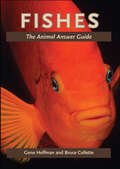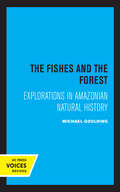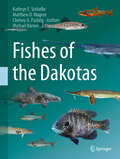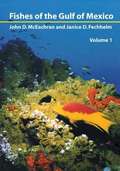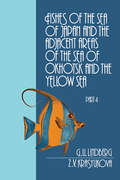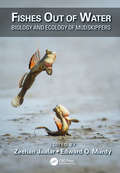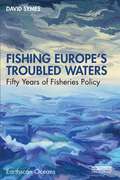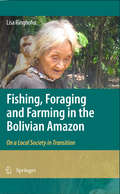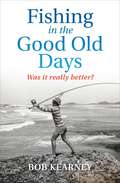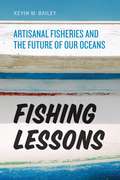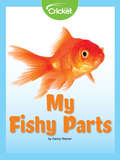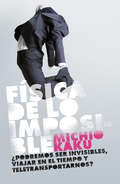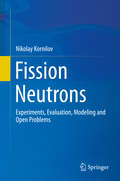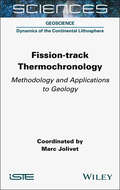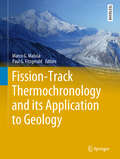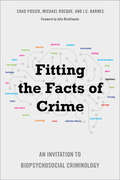- Table View
- List View
Fishes: A Field and Laboratory Manual on Their Structure, Identification and Natural History
by Gregor Cailliet Milton Love Alfred EbelingNow available from Waveland Press, this comprehensive, geographically balanced manual offers readers complete hands-on coverage of morphology, identification, and classification, physiological adaptations, and natural history. The book's taxonomic and geographic coverage is impressively broad as well, applying to a variety of fishes and areas: jawless, cartilaginous, and bony, fresh- and saltwater, temperate and tropical, and inshore and offshore. Helpful discussions and explanations introduce the guidebook's collection of well-designed exercises, making the connections between principles and specific inquiries easier to formulate. This approach works to help readers transform memorized facts into concepts that stimulate further explorations.
Fishes: A Guide to Their Diversity
by Philip A. HastingsThere are more than 33,000 species of living fishes, accounting for more than half of the extant vertebrate diversity on Earth. This unique and comprehensive reference showcases the basic anatomy and diversity of all 82 orders of fishes and more than 150 of the most commonly encountered families, focusing on their distinctive features. Accurate identification of each group, including its distinguishing characteristics, is supported with clear photographs of preserved specimens, primarily from the archives of the Marine Vertebrate Collection at Scripps Institution of Oceanography. This diagnostic information is supplemented by radiographs, additional illustrations of particularly diverse lineages, and key references and ecological information for each group. An ideal companion to primary ichthyology texts, Fishes: A Guide to Their Diversity gives a broad overview of fish morphology arranged in a modern classification system for students, fisheries scientists, marine biologists, vertebrate zoologists, and everyday naturalists. This survey of the most speciose group of vertebrates on Earth will expand the appreciation of and interest in the amazing diversity of fishes.
Fishes: The Animal Answer Guide (The Animal Answer Guides: Q&A for the Curious Naturalist)
by Gene Helfman Bruce ColletteOne fish, two fish, red fish, nearly thirty thousand species of fish—or fishes, as they are properly called when speaking of multiple species. This is but one of many things the authors of this fascinatingly informative book reveal in answering common and not-so-common questions about this ubiquitous group of animals.Fishes range in size from tiny gobies to the massive Ocean Sunfish, which weighs thousands of pounds. They live in just about every body of water on the planet. Ichthyologists Gene Helfman and Bruce Collette provide accurate, entertaining, and sometimes surprising answers to over 100 questions about these water dwellers, such as "How many kinds of fishes are there?" "Can fishes breathe air?" "How smart are fishes?" and "Do fishes feel pain?" They explain how bony fishes evolved, the relationship between them and sharks, and why there is so much color variation among species. Along the way we also learn about the Devils Hole Pupfish, which has the smallest range of any vertebrate in the world; Lota lota, the only freshwater fish to spawn under ice; the Candiru, a pencil-thin Amazonian catfish that lodges itself in a very personal place on male bathers and must be removed surgically; and many other curiosities.With more than 100 photographs—including two full-color photo galleries—and the most up-to-date facts on the world's fishes from two premier experts, this fun book is the perfect bait for any curious naturalist, angler, or aquarist.
Fishes: An Introduction to Ichthyology
by Peter B. Moyle Joseph J. CechThis book provides a comprehensive and current source of information on fishes--including systematics, zoogeography, behavior, and conservation of fishes--that is often needed by professionals as background for writing accurate reports. This book covers the structure and physiology, evolution and taxonomy, zoogeography, and ecology and conservation of fishes. For fisheries biologists, conservation biologists, and aquatic ecologists that need an up-to-date reference on Ichthyology.
The Fishes and the Forest: Explorations in Amazonian Natural History
by Michael GouldingThis title is part of UC Press's Voices Revived program, which commemorates University of California Press’s mission to seek out and cultivate the brightest minds and give them voice, reach, and impact. Drawing on a backlist dating to 1893, Voices Revived makes high-quality, peer-reviewed scholarship accessible once again using print-on-demand technology. This title was originally published in 1980.
Fishes of the Dakotas
by Kathryn E. Schlafke Matthew D. Wagner Chelsey A. PasbrigThis book describes all of the fishes found in North and South Dakota, USA. It contains a description of the waters and geology of the two states, information on the major rivers and water basins, detailed distribution tables, and a dichotomous key (already tested and in university use). A brief description of each fish family is included, and for each individual fish species found in North and South Dakota, high resolution color images, range maps, descriptions, and life histories are included. All of the information is referenced. The book also shows all of the fish sampling sites, briefly describes the history of fish sampling and identification in the Dakotas, and mentions the prominent individuals. This is the first book of its kind - the first comprehensive compilation describing every fish found in the Dakotas with all of the supplemental information.
Fishes of the Gulf of Mexico: Myxiniformes to Gasterosteiformes
by John D. Mceachran Janice D. FechhelmThe Gulf of Mexico is the ninth largest body of water in the world and contains over 15 percent of all known species of marine fishes. This diverse fish fauna has been the subject of many publications, but, until now, no work has ever surveyed all known species, including the deep sea fishes and those of the southern Gulf.<P><P>This book is the first of two volumes that will cover the entire fish fauna of the Gulf of Mexico. An introductory section that outlines the Gulf's geographical setting, geological origin, current patterns, tides, sediments, meteorology, ecology, and biological exploration is followed by a key for the forty-four orders of fishes known from the Gulf. Keys and descriptions are provided for families, which are arranged phylogenetically, and for the species, which are arranged alphabetically, described, and distinguished from similar species. All but a few species are illustrated.
Fishes of the Sea of Japan and the Adjacent Areas of the Sea of Okhotsk and the Yellow Sea
by G.U. LindbergThis part completes the review of the largest and economically richest order of fishes, Perciformes, begun in Part 3. It includes 12 suborders with keys and brief descriptions to 230 species, and information on their ecology and distribution.
Fishes Out of Water: Biology and Ecology of Mudskippers (CRC Marine Science)
by Zeehan Jaafar Edward O. MurdyMudskippers are amphibious fishes native to the Indo-West Pacific and tropical western Africa. Unlike most fishes, mudskippers emerse to forage, find mates, and defend territories. Adaptations to their morphology, physiology and behavior enable mudskippers to accommodate both aquatic and terrestrial habitats. For these traits, mudskippers have long captured the fascination of scientists, naturalists, and fish hobbyists. Some mudskipper taxa (e.g. Periophthalmodon spp., Periophthalmus spp., Boleophthalmus spp.) are readily observed on mudflats and mangrove forests during the ebb tide. Correspondingly, these conspicuous and widespread taxa are relatively well-studied. The autecology and basic biology for the remaing taxa (e.g. Apocryptodon spp. and Oxuderces spp.) are still poorly understood. Fishes Out of Water: Biology and Ecology of Mudskippers is the first comprehensive book to synthesize published scientific information and observation on these fishes. Two dozen subject experts present thorough overviews in fifteen distinct chapters. Contents span mudskipper anatomy, distribution, systematics, physiology, ecology, and conservation. Unique adaptations to terrestriality are discussed within the context of each chapter foci. This authoritative reference equips the reader with the basic foundation to understand mudskipper biology and ecology, while providing a framework in which emerging data are discussed. The book will be of interest to a broad range of students, researchers, and professionals in ichthyology, evolution, ecology, animal behavior, and comparative physiology.
Fishing Europe's Troubled Waters: Fifty Years of Fisheries Policy (Earthscan Oceans)
by David SymesSpanning the last 50 years of fisheries policy in Europe, this book is the parting contribution and career-spanning reflection from one of Europe’s most renowned social scientists working in the field of fisheries management and policy. The last 50 years have without doubt been the most turbulent years in the history of North Atlantic fisheries – a turbulence brought about by the actions of fishers, scientists and above all politicians. It is a period of change that sees a radical redrawing of the political geography of fisheries, globalisation of trade, the development of fisheries management towards increasingly restrictive regulation, and declining fish stocks. The book explains why the bold but deeply flawed Common Fisheries Policy persistently failed to deliver its basic goal of sustainable fisheries. The spotlight falls on the monolithic, highly centralised, command and control nature of the Policy that strives to apply a universal ‘one size fits all’ approach, thus creating a governing system wholly unsuited to the system to be governed, out of kilter with preferred models of governance, and disconnected from the practical realities of fishing as a livelihood in a challenging environment. A final section on Brexit focuses on its halting progress from concept to reality, the implications for the fisheries sector and the fateful final negotiations with the EU over the fisheries question. Seeking to explain why the anticipated benefits for the UK industry failed to materialise, attention is drawn to the misplaced political hubris over regaining ‘sovereignty’ in areas like the North Sea. This book will be essential reading for students, scholars, professionals and policymakers working on fisheries, marine governance, natural resource management, environmental policy and the European Project.
Fishing, Foraging and Farming in the Bolivian Amazon
by Lisa RinghoferEmpirical in character, this book analyses the society-nature interaction of the Tsimane', a rural indigenous community in the Bolivian Amazon. Following a common methodological framework, the material and energy flow (MEFA) approach, it gives a detailed account of the biophysical exchange relations the community entertains with its natural environment: the socio-economic use of energy, materials, land and time. Equally so, the book provides a deeper insight into the local base of sociometabolic transition processes and their inherent dynamics of change. The local community described in this publication stands for the many thousands of rural systems in developing countries that, in light of an ever more globalising world, are currently steering a similar - but maybe differently-paced - development course. This book presents insightful methodological and conceptual advances in the field of sustainability science and provides a vital reader for students and researchers of human ecology, ecological anthropology, and environmental sociology. It equally contributes to improving professional development work methods.
Fishing in the Good Old Days: Was it really better?
by Bob KearneyBob Kearney has been addicted to recreational fishing and is a devout keeper of the legends and lore of the Australian angler. He is also a world authority on fisheries and marine ecosystem management. In Fishing in the Good Old Days, Kearney looks back on his six decades of experience as a fisherman in earnest pursuit of the iconic jewfish off the rocks and beaches of northern New South Wales. He recalls unforgettable adventures, colourful personalities, the thrill of the chase and, yes, the ones that got away. Along the way, he exposes the environmental consequences of poorly planned coastal activities. Kearney also addresses a serious question: Is the holistic experience of fishing for fun, now, truly not as good as it was in the 1960s? Of course, this question rests on many others about recreational and commercial fishing practice, fisheries management, coastal and marine conservation, and the impact of the terrestrial world, including through human population growth and climate change. With a grasp of the scientific research as acute as his ear for the anglers' voices of his youth, Kearney demonstrates that the answer to his question is far from straightforward.
Fishing Lessons: Artisanal Fisheries and the Future of Our Oceans
by Kevin M. BaileyFish bones in the caves of East Timor reveal that humans have systematically fished the seas for at least 42,000 years. But in recent centuries, our ancient, vital relationship with the oceans has changed faster than the tides. As boats and fishing technology have evolved, traditional fishermen have been challenged both at sea and in the marketplace by large-scale fishing companies whose lower overhead and greater efficiency guarantee lower prices. In Fishing Lessons, Kevin M. Bailey captains a voyage through the deep history and present course of this sea change—a change that has seen species depleted, ecosystems devastated, and artisanal fisheries transformed into a global industry afloat with hundreds of billions of dollars per year. Bailey knows these waters, the artisanal fisheries, and their relationship with larger ocean ecology intimately. In a series of place-based portraits, he shares stories of decline and success as told by those at the ends of the long lines and hand lines, channeling us through the changing dynamics of small-scale fisheries and the sustainability issues they face—both fiscal and ecological. We encounter Paolo Vespoli and his tiny boat, the Giovanni Padre,in the Gulf of Naples; Wenche, a sea Sámi, one of the indigenous fisherwomen of Norway; and many more. From salmon to abalone, the Bay of Fundy to Monterey and the Amazon, Bailey’s catch is no fish tale. It is a global story, casting a net across waters as vast and distinct as Puget Sound and the Chilean coast. Sailing across the world, Bailey explores the fast-shifting current of how we gather food from the sea, what we gain and what we lose with these shifts, and potential solutions for the murky passage ahead.
Fishing North Carolina's Outer Banks
by Stan UlanskiIn this hands-on, how-to guide to fishing North Carolina's Outer Banks, expert fisherman Stan Ulanski combines his enthusiasm, his experience, and his scientific expertise to show anglers how to catch more fish. Focusing on the essential but often misunderstood links between recreational fishing and the biology, geography, and natural history of the region,Fishing North Carolina's Outer Banksfosters an understanding of the aquatic environment of one of the nation's prime fishing destinations. Ulanski reveals the best approaches to the six main Outer Banks angling scenarios: surf, pier, sound, offshore, inshore, and reef, ledge, and shipwreck fishing. The book features illustrated fish profiles--each loaded with essential information, including identification, food value, and habitat pointers--and species-specific fishing tips for thirty-five of the Outer Banks' most common game fish. And, once you've made your catch, Ulanski provides important storing, cleaning, and cooking advice--including six of his favorite fresh fish recipes. This is a trusty tacklebox tool for planning fishing trips to the Outer Banks and for understanding the underwater setting of the fish you're out to catch.
Fishy Parts
by Danny ResnerWe use our lungs to get oxygen from the air to breathe. Fish use their gills to get oxygen from water! Learn about the different body parts fish have and how they use them to live. Guess what body part helps the Salmon find its way home!
Física de lo imposible: ¿Podremos ser invisibles, viajar en el tiempo y teletransportarnos?
by Michio Kaku¿Hasta qué punto los ingenios de la ciencia ficción que hoy consideramos imposibles pueden ser habituales en el futuro? Teletransporte, máquinas del tiempo, campos de fuerza y naves intergalácticas: ¿materia de ciencia ficción o tecnologías potencialmente disponibles en el futuro? Inspirado por los mundos fantásticos de H.G. Wells, Star Trek o La guerra de las galaxias, el prestigioso físico teórico y divulgador Michio Kaku lanza una mirada inteligente, seria y a menudo sorprendente a lo que nuestra actual comprensión de las leyes del universo nos permite vislumbrar en el futuro. Un fascinante viaje por mundos hasta ahora solo soñados por la ciencia ficción, que ofrece nuevos retos a las próximas generaciones de científicos capaces de desafiar las imposibilidades de nuestro tiempo. Reseñas:«Física de lo imposible trata de explicar por qué algunas visiones del futuro podrían llegar a realizarse mientras que otras probablemente permanecerán más allá de los límites de lo posible [...] La ciencia ficción explora a menudo estas cuestiones; la ciencia en cambio permanece callada en este punto. El trabajo de Kaku ayuda a llenar un vacío.»The Economist «Aquello que muchos consideran un vuelo de la imaginación se está materializando gracias a recientes descubrimientos científicos, que van desde tímidos progresos en teletransporte hasta la creación de pequeñas cantidades de antimateria y transmisiones más rápidas que la velocidad de la luz. Kaku demuestra que en los maravillosos mundos de la ciencia las cosas imposibles suceden a diario.»Publishers Weekly «Pocos físicos teóricos se plantearían explorar algunas de estas posibles imposibilidades, y hay que felicitar a Kaku por hacerlo. Es un excelente estímulo intelectual.»Los Angeles Times
Física de lo imposible
by Michio KakuDesde el tele transporte hasta la telequinesia, Michio Kaku acude al mundo de la ciencia ficción para explorar las premisas y los límites de las leyes de la física que aceptamos hoy día. En una obra atractiva y provocadora, Kaku explica, por ejemplo, cómo la ciencia óptica y el electromagnetismo permitirán algún día que la luz rodee un objeto, haciéndolo invisible; cómo nuevos cohetes, velas de láser, motores de antimateria y nanocohetes pueden acercarnos a las estrellas más cercanas; cómo la telepatía y la telequinesia, antes despreciadas como pseudociencia, pueden lograrse gracias a resonancias magnéticas, ordenadores, superconductores y nanotecnología. El resultado es una extraordinaria aventura científica, que lleva a los lectores a un viaje inolvidable por los confines de la ciencia.
Fission Neutrons
by Nikolay KornilovAlthough the fission of heavy nuclei was discovered over 75 years ago, many problems and questions still remain to be addressed and answered. The reader will be presented with an old, but persistent problem of this field: The contradiction between Prompt Fission Neutron (PFN) spectra measured with differential (microscopic) experiments and integral (macroscopic and benchmark) experiments (the Micro-Macro problem). The difference in average energy is rather small ~3% but it is stable and we cannot explain the difference due to experimental uncertainties. Can we measure the PFN spectrum with high accuracy? How may we compare results of different experiments to provide better accuracy? Are our traditional theoretical models correct? What can be done to solve the Micro-Macro problem in future? These questions are discussed in this monograph for the reader. The current work will be of interest to graduate students and researchers, particularly those working in nuclear and neutron physics.
Fission Product Processes In Reactor Accidents
by J. T. RogersThe Three Mile Island and Chernobyl nuclear incidents emphasized the need for the world-wide nuclear community to cooperate further and exchange the results of research in this field in the most open and effective manner. Recognizing the roles of heat and mass transfer in all aspects of fission-product behavior in sever reactor accidents, the Executive Committee of the International Centre for Heat and Mass Transfer organized a Seminar on Fission Product Transport Processes in Reactor Accidents. This book contains the eleven of the lectures and all the papers presented at the seminar along with four invited papers that were not presented and a summary of the closing session.
Fission-track Thermochronology: Methodology and Applications to Geology (ISTE Consignment)
by Marc JolivetLow-temperature thermochronology has become an essential tool when studying near-surface geological processes. Time-temperature constraints are vital to quantify and describe a large variety of geological processes, such as relief building, erosion and sedimentation or the maturation of organic matter in sedimentary basins. After a brief history covering the discovery of fission tracks to their first applications in geochronology, Fission-track Thermochronology presents a complete description of not only the fission-track, but also the (U Th Sm)/He thermochronology approaches, both on basement rocks and on sediments. Firstly, the physical and chemical processes that underlie these techniques are addressed, and the analytical methods are described in detail. A particular focus is placed on the latest developments, such as the use of laser-ablation ICP-MS, and a whole chapter is dedicated to statistical modeling of the data. Finally, numerous examples of applications to geological questions will provide the reader with a comprehensive overview of the possibilities of low temperature thermochronology in solving geological and geomorphological questions.
Fission-Track Thermochronology and its Application to Geology (Springer Textbooks in Earth Sciences, Geography and Environment)
by Marco G. Malusà Paul G. FitzgeraldThis book is focused on the basics of applying thermochronology to geological and tectonic problems, with the emphasis on fission-track thermochronology. It is conceived for relatively new practitioners to thermochronology, as well as scientists experienced in the various methods. The book is structured in two parts. Part I is devoted to the fundamentals of the fission-track method, to its integration with other geochronologic methods, and to the basic principles of statistics for fission-track dating and sedimentology applied to detrital thermochronology. Part I also includes the historical development of the technique and thoughts on future directions. Part II is devoted to the geological interpretation of the thermochronologic record. The thermal frame of reference and the different approaches for the interpretation of fission-track data within a geological framework of both basement and detrital studies are discussed in detail. Separate chapters demonstrate the application of fission-track thermochronology from various perspectives (e.g., tectonics, petrology, stratigraphy, hydrocarbon exploration, geomorphology), with other chapters on the application to basement rocks in orogens, passive continental margins and cratonic interiors, as well as various applications of detrital thermochronology.
Fit fürs Labor: Molekularbiologie und Zellbiologie
by Alan J. Hargreaves Philip L.R. BonnerSouverän durchs Praktikum: Macht Studierende der Biologie, Biochemie oder Biotechnologie fit für die ungewohnte Arbeitsumgebung eines wissenschaftlichen Labors Fit fürs Labor: Molekularbiologie & Zellbiologie gibt Studierenden in den Biowissenschaften ein kompaktes Nachschlagewerk an die Hand, das alle wesentlichen molekularbiologischen und zellbiologischen Arbeitsmethoden erklärt. Von der Extraktion über die Aufreinigung zur Funktionsbestimmung von Nukleinsäuren und Proteinen, grundlegenden Zellkulturtechniken und immunchemischen Verfahren wird die Bandbreite biowissenschaftlicher Labortechniken abgedeckt. Zu einem erfolgreichen Laborversuch gehört auch die Vorbereitung des Versuchs und der dazu nötigen Materialien, die Dokumentation der gewonnenen Daten sowie deren Auswertung. Daher sind neben Schritt-für-Schritt-Erläuterungen zur Versuchsdurchführung zahlreiche Beispiel zur Analyse und Interpretation der aus dem Experiment gewonnenen Daten enthalten. Vom Ansetzen einer Stammlösung bis zur Durchführung eines biologischen Assays werden alle wichtigen Labortechniken erklärt Mehr als 40 Übungen und Beispielrechnungen sind enthalten, die die typischen Anforderungen und Aufgaben in einem Laborpraktikum abdecken Angereichert mit vielen hilfreichen Definitionen und kleinen Exkursen, die das Leben & Lernen leichter machen Mit Fit fürs Labor: Molekularbiologie und Zellbiologie kann jede und jeder ein biowissenschaftliches Laborpraktikum meistern!
Fitting the Facts of Crime: An Invitation to Biopsychosocial Criminology
by Chad Posick Michael Rocque J.C. BarnesBiosocial criminology—and biosocial criminologists—focuses on both the environmental and biological factors that contribute to antisocial behavior. Importantly, these two domains are not separate parts of an equation but pieces of the same puzzle that fit together for a complete picture of the causes of crime/antisocial behavior. Fitting the Facts of Crime applies a biopsychosocial lens to the “13 facts of crime” identified by John Braithwaite in his classic book, Crime, Shame and Reintegration. The authors unpack established facts—about gender and sex, age, environment, education, class, social bonds and associations, stress, and other influences—providing both empirical research and evidence from biopsychosocial criminology to address the etiology behind these facts and exactly how they are related to deviant behavior. With their approach, the authors show how biopsychosocial criminology can be a unifying framework to enrich our understanding of the most robust and well-established topics in the field. In so doing, they demonstrate how biological and psychological findings can be responsibly combined with social theories to lend new insight into existing inquiries and solutions. Designed to become a standard text for criminology in general, Fitting the Facts of Crime introduces key concepts and applies them to real-world situations.
The Five Ages of the Universe: Inside the Physics of Eternity
by Fred C. Adams Greg LaughlinA Simon & Schuster eBook. Simon & Schuster has a great book for every reader.
The Five Biggest Ideas in Science
by Charles M. Wynn Arthur W. WigginsThe five major ideas that have revolutionized history and human perceptions are elaborately described with many simple illustrations and cartoons.


